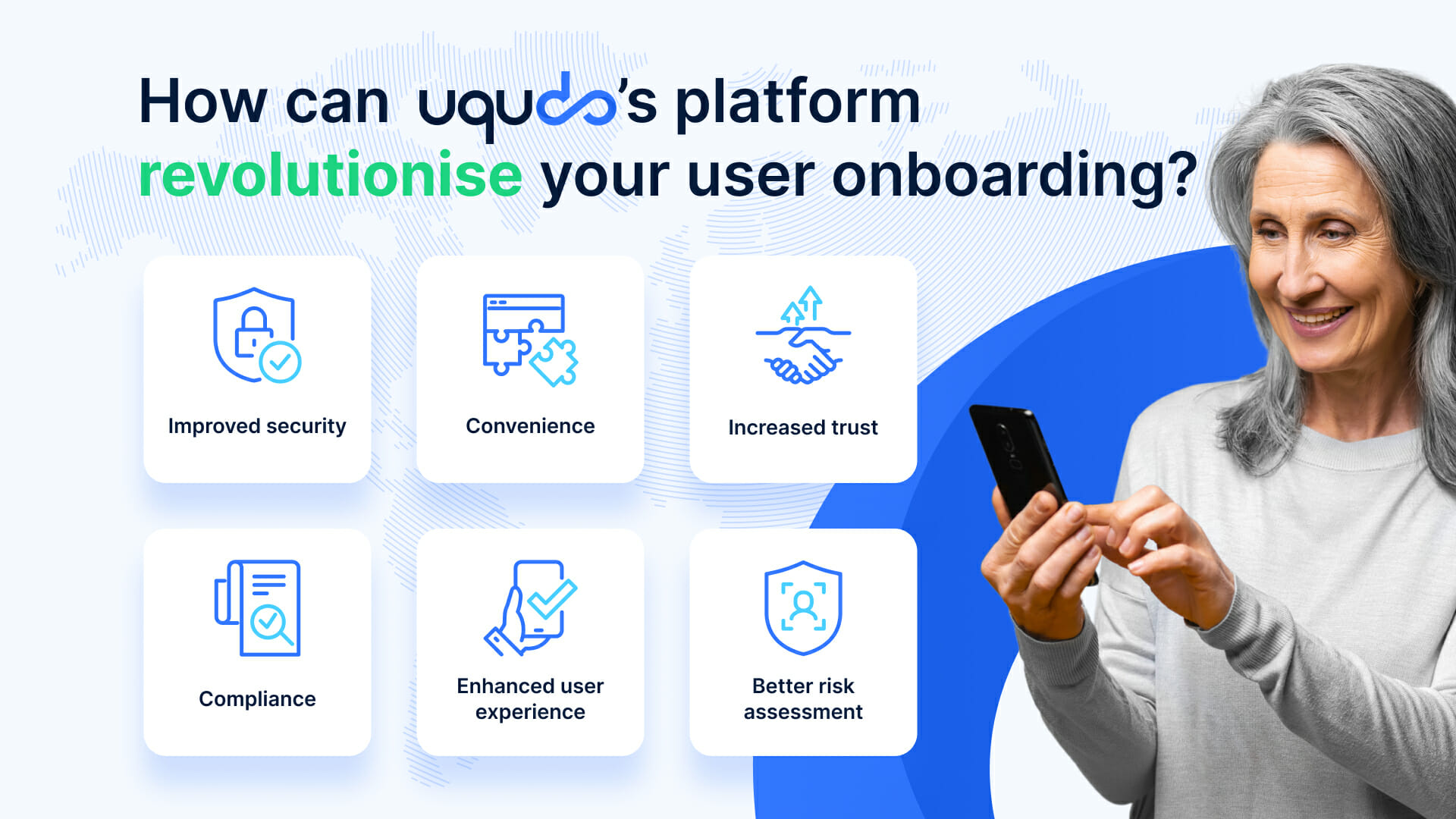Table Of Contents
- How does BNPL work?
- How is identity verification important in BNPL?
- What methods of identity verification can be used to verify BNPL user identities?
- What are the benefits of digital identity verification in BNPL?
- What is the overall impact of identity verification on BNPL consumers?
- How can uqudo support BNPL companies’ identity verification process?
Did you know that 60% of consumers across the world said that they would prefer a BNPL (Buy Now, Pay Later) payment method over traditional credit cards due to ease of payments and lack of interest rates?
BNPL, a common payment method today, lets customers purchase goods and services and pay for them later in instalments. Remember the time you were short of cash while buying that refrigerator? BNPL solves this problem by letting consumers pay later in smaller, manageable amounts. This in turn makes products and services more accessible and convenient for people with limited credit and those who want to avoid high-interest rates.
The BNPL industry initially started off as an efficient way for consumers to pay for goods and services but has now evolved into an affordability tool helping people to manage their payments and finances better. A few years ago, BNPL was considered an option only for expensive, one-off items like cars. Today, BNPL is becoming increasingly popular in everyday purchases including groceries, clothes and bill payments.
As BNPL has gained popularity in recent years, so has the potential for fraud in deferred payment plans. In this, fraudsters use someone else’s identity to open a BNPL account or apply for credit under a false identity. The fraudster then uses the BNPL account or credit to make purchases or withdraw money, leaving the victim with the debt. In some cases, fraudsters may also use fake or stolen documents to apply for BNPL accounts, making it more difficult for lenders to detect fraud.
Technological advancements in AI and machine learning have today made it easier for financial institutions to reduce fraud while using a BNPL structure, and a comprehensive identity verification procedure is a key aspect of this. More on this in the following sections!
How does BNPL work?
BNPL (Buy Now Pay Later) is a type of payment system that lets customers purchase goods and services without paying for them upfront. Instead, consumers can pay in instalments over a specific period of time, generally without interest or fees. BNPL has become an increasingly popular payment option, especially among younger consumers who prefer not to pay the full cost of an item upfront.
Most BNPL programs differ according to a company’s requirements, but typically consist of the following steps:
1. Customer selects the BNPL option at checkout
The customer selects the BNPL option at the checkout when making a purchase and provides their personal information to the BNPL provider.
2. Credit check and approval
The BNPL provider performs a credit check to determine if the customer is eligible for the payment plan. If approved, the customer can proceed with the purchase.
3. Payment plan
The customer pays for the purchase in instalments over a specified period of time, as agreed with the BNPL provider.
4. Repayment
Customers make repayments according to the terms agreed upon, which typically include the purchase amount, interest, and fees. The repayments can be made in instalments or as a lump sum, and they may be due on a weekly, bi-weekly, or monthly basis.
5. Fees and penalties
If the customer misses a payment or fails to repay the loan according to the payment plan, they may be charged late fees or penalties.
6. Payoffs
When all repayments have been made, the debt is considered paid off, and the customer’s credit score may be positively impacted. This can help the customer improve their credit standing and make it easier to obtain credit in the future.
In summary, BNPL is essentially a form of consumer credit that allows customers to pay for their purchases over time, rather than all at once.
How is identity verification important in BNPL?
Now that we’ve understood how BNPL works, let’s get into the main point of this article, identity verification in the BNPL sector.
Today, consumers prefer BNPL as a convenient alternative to traditional credit card payments. BNPL transactions are unique because they involve customers making payments over time, rather than paying the full amount upfront. This creates an increased risk of fraud, as there is more time for a fraudster to impersonate someone else to make unauthorised purchases.
This has definitely led to a rise in BNPL usage, but with it comes a higher risk of fraud. In order to mitigate this risk and ensure secure transactions, identity verification has become an important aspect of the BNPL process.
In BNPL transactions, identity verification helps prevent fraudulent activities such as identity theft, money laundering and unauthorised transactions. By verifying user identities, BNPL companies can confirm that the person using the service is the legitimate owner of the payment method, and prevent any unauthorised transactions from occurring.
Moreover, identity verification is also crucial for compliance with regulatory requirements, such as KYC (Know Your Customer) and AML (Anti-Money Laundering) laws, which are designed to prevent financial crime. These regulations require financial institutions to verify the identity of their customers to ensure that they are not engaging in any illegal activities such as terrorism financing or other illicit activities.
In short, identity verification in BNPL helps create a safer and more trustworthy environment for both the customers and the companies. By ensuring that the customers are who they claim to be, BNPL companies can reduce the risk of fraud, comply with regulations, and offer a more secure and reliable service to their customers.
What methods of identity verification can be used to verify BNPL user identities?
A digital method of identity verification can make customer onboarding easier and more secure for BNPL companies. Some commonly used methods (generally in combinations) to verify user identities are:
1. Digital ID verification
National IDs now exist in digital forms in many countries today. These national IDs can be verified against numerous databases to help organisations confirm the identity of their customers.
For this, the user has to first scan or upload identity documents to the digital platform, from which identity data can be extracted using softwares. This extracted data is compared to the current database. A combination of AI (Artificial Intelligence) and machine learning can easily identify if the document is tampered with, helping user authentication.
2. Biometric verification
Another safe method of digital identification is the use of biometrics, such as a person’s voice, face, or fingerprints, to confirm identities. Since each person’s biometrics are distinct, biometric verification is dependable and safe. By avoiding the hassle of having to remember numerous passwords, biometric authentication improves user experience as well.
3. Two-factor authentication
Due to the higher security it offers, two-factor authentication is another frequently employed method to prove identities. For this, the user has to first enter their login information. After this, users are required to provide an OTP (One-Time Password) that was either sent to their phones or email address in order to log in. this added layer of security ensures that the user data is protected from fraudsters even if their credentials are compromised.
4. Knowledge-based identification
Knowledge-based authentication verifies uses via information only they are aware of. These security questions are asked to users when they register on a platform, whose answers are used to verify idneitites. Knowledge-based security questions add an additional degree of protection when used together with passwords and biometric authentication.
5. Liveness detection
Using computer vision technology, liveness detection verifies that the subject of the camera is indeed there and alive, as opposed to being a video or a mask. When used along with facial recognition, liveness detection helps prevent spoofing, thereby reducing identity theft and fraud.
What are the benefits of digital identity verification in BNPL?
A strong identity platform plays an important role in protecting BNPL companies from fraudsters. Some key benefits of digital identity verification in BNPL services include:

1. Improved security
Digital identity verification helps to prevent fraud and protect against identity theft by verifying the identity of the person who is applying for a loan. This helps to ensure that only legitimate users are approved for loans, reducing the risk of fraudulent activities.
2. Convenience
Digital identity verification processes can be completed quickly and efficiently, allowing customers to complete the process from the comfort of their own homes. This eliminates the need for customers to visit physical locations, reducing the time and effort required to complete the verification process.
3. Increased trust
By verifying customers’ identities, BNPL services can build trust with both customers and merchants. Customers are more likely to trust a service that takes steps to verify their identity, while merchants are more likely to trust transactions that have been verified.
4. Compliance
Digital identity verification can help BNPL services comply with regulatory requirements, such as KYC and AML regulations. This reduces the risk of potential legal penalties and reputational damage.
5. Enhanced user experience
Digital identity verification provides a more seamless experience for customers, reducing friction and making the BNPL process smoother. This can improve customer satisfaction and increase the likelihood of repeat business.
6. Better risk assessment
Digital identity verification can provide BNPL services with additional information to make more informed decisions on loan approvals, reducing the risk of default. This can help to improve the financial stability of the BNPL service and reduce the risk of loss.
Overall, digital identity verification can bring numerous benefits to BNPL services, from increased security and trust to improved risk assessment and compliance.
What is the overall impact of identity verification on BNPL consumers?
Identity verification is an important aspect of BNPL (Buy Now Pay Later) transactions, as it helps to ensure the security of both the user and the merchant. With the rise of e-commerce, the need for secure and reliable payment systems has become increasingly important, and BNPL companies are no exception. Consumers are eager to embrace new payment methods that make shopping convenient, but they also want to be sure their personal information and financial data are safe.
While identity verification may increase the number of steps required for a user to complete a purchase, it can also help to build trust and provide peace of mind for the user, knowing that their personal and financial information is secure.
On the other hand, if the verification process is too cumbersome or intrusive, it can negatively impact the user experience and lead to a decrease in customer satisfaction. Thus, it’s important for BNPL companies to strike a balance between security and user experience when implementing identity verification measures.
The impact of identity verification on the customer experience varies depending on the method used by the BNPL company. Some BNPL companies use manual identity verification methods, which can be time-consuming and can cause delays in the approval process.
Additionally, BNPL companies that use automated identity verification methods are faster and more efficient. Automated identity verification can provide a seamless experience for customers, allowing them to complete their purchases quickly and easily.
How can uqudo support BNPL companies’ identity verification process?
Being a comprehensive digital identity verification company, uqudo goes beyond traditional identity verification methods to make your user verification process fast, regulatory compliant and cheap. Our efficient, seamless and secure KYC (Know Your Customer), Screening, KYB (Know Your Business) and Authentication processes can fit easily into your user onboarding journey, enhancing your customers’ experience.
Our speedy and compliant KYC process consists of powerful AI document scanning and OCR technologies, that can extract identity data within milliseconds, streamlining your onboarding workflow and reducing data inaccuracies.
uqudo’s Screening platform consists of checks against 1500+ global Sanctions Lists, 1.7+ million (PEPs) Politically Exposed Persons and 3+ billion Adverse Media articles, letting you know if your customers are worthy of doing business with and eliminating risks from your company.
With BNPL companies gaining heavily from using biometrics as a mode of user authentication, uqudo’s biometric identity platform can help validate your users’ payments using biometric data, strengthening your platform’s security and streamlining the user experience.
uqudo’s identity platform charges companies only on successful onboarding, letting your firm have complete control over your customer acquisition costs.
In addition to being a highly reliable and compliant digital identity provider, uqudo’s advanced tech stack can be fully customised to meet your needs.
Interesting, isn’t it? Get in touch with us to learn more.


